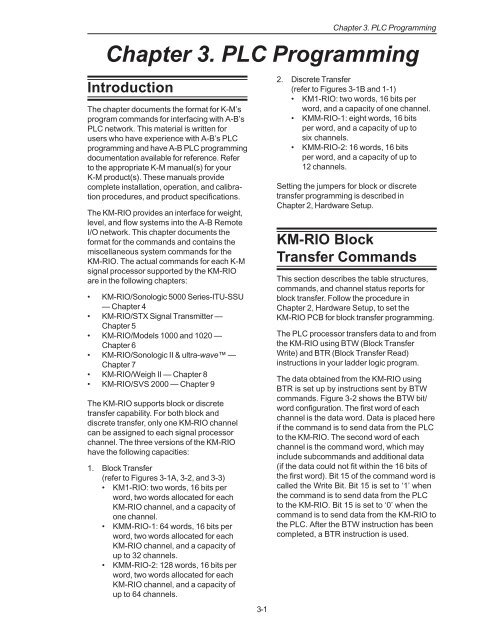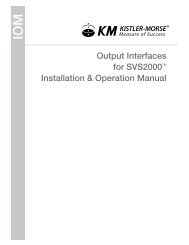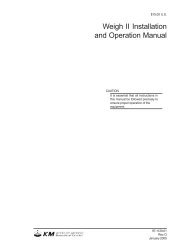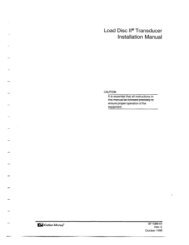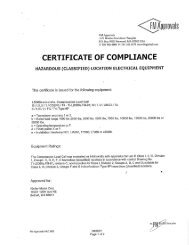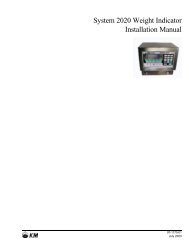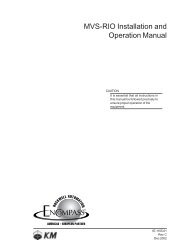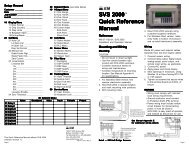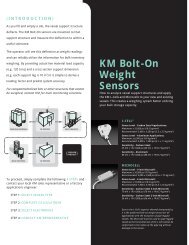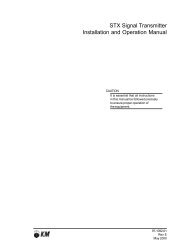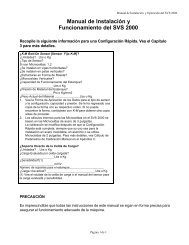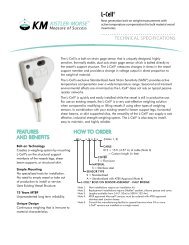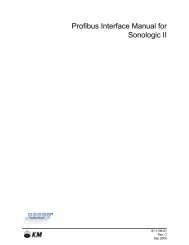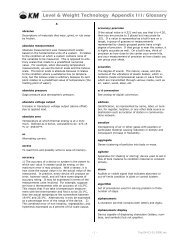KM-RIO Installation and Operation Manual - Kistler-Morse
KM-RIO Installation and Operation Manual - Kistler-Morse
KM-RIO Installation and Operation Manual - Kistler-Morse
You also want an ePaper? Increase the reach of your titles
YUMPU automatically turns print PDFs into web optimized ePapers that Google loves.
Chapter 3. PLC ProgrammingChapter 3. PLC ProgrammingIntroductionThe chapter documents the format for K-M’sprogram comm<strong>and</strong>s for interfacing with A-B’sPLC network. This material is written forusers who have experience with A-B’s PLCprogramming <strong>and</strong> have A-B PLC programmingdocumentation available for reference. Referto the appropriate K-M manual(s) for yourK-M product(s). These manuals providecomplete installation, operation, <strong>and</strong> calibrationprocedures, <strong>and</strong> product specifications.The <strong>KM</strong>-<strong>RIO</strong> provides an interface for weight,level, <strong>and</strong> flow systems into the A-B RemoteI/O network. This chapter documents theformat for the comm<strong>and</strong>s <strong>and</strong> contains themiscellaneous system comm<strong>and</strong>s for the<strong>KM</strong>-<strong>RIO</strong>. The actual comm<strong>and</strong>s for each K-Msignal processor supported by the <strong>KM</strong>-<strong>RIO</strong>are in the following chapters:• <strong>KM</strong>-<strong>RIO</strong>/Sonologic 5000 Series-ITU-SSU— Chapter 4• <strong>KM</strong>-<strong>RIO</strong>/STX Signal Transmitter —Chapter 5• <strong>KM</strong>-<strong>RIO</strong>/Models 1000 <strong>and</strong> 1020 —Chapter 6• <strong>KM</strong>-<strong>RIO</strong>/Sonologic II & ultra-wave —Chapter 7• <strong>KM</strong>-<strong>RIO</strong>/Weigh II — Chapter 8• <strong>KM</strong>-<strong>RIO</strong>/SVS 2000 — Chapter 9The <strong>KM</strong>-<strong>RIO</strong> supports block or discretetransfer capability. For both block <strong>and</strong>discrete transfer, only one <strong>KM</strong>-<strong>RIO</strong> channelcan be assigned to each signal processorchannel. The three versions of the <strong>KM</strong>-<strong>RIO</strong>have the following capacities:1. Block Transfer(refer to Figures 3-1A, 3-2, <strong>and</strong> 3-3)• <strong>KM</strong>1-<strong>RIO</strong>: two words, 16 bits perword, two words allocated for each<strong>KM</strong>-<strong>RIO</strong> channel, <strong>and</strong> a capacity ofone channel.• <strong>KM</strong>M-<strong>RIO</strong>-1: 64 words, 16 bits perword, two words allocated for each<strong>KM</strong>-<strong>RIO</strong> channel, <strong>and</strong> a capacity ofup to 32 channels.• <strong>KM</strong>M-<strong>RIO</strong>-2: 128 words, 16 bits perword, two words allocated for each<strong>KM</strong>-<strong>RIO</strong> channel, <strong>and</strong> a capacity ofup to 64 channels.3-12. Discrete Transfer(refer to Figures 3-1B <strong>and</strong> 1-1)• <strong>KM</strong>1-<strong>RIO</strong>: two words, 16 bits perword, <strong>and</strong> a capacity of one channel.• <strong>KM</strong>M-<strong>RIO</strong>-1: eight words, 16 bitsper word, <strong>and</strong> a capacity of up tosix channels.• <strong>KM</strong>M-<strong>RIO</strong>-2: 16 words, 16 bitsper word, <strong>and</strong> a capacity of up to12 channels.Setting the jumpers for block or discretetransfer programming is described inChapter 2, Hardware Setup.<strong>KM</strong>-<strong>RIO</strong> BlockTransfer Comm<strong>and</strong>sThis section describes the table structures,comm<strong>and</strong>s, <strong>and</strong> channel status reports forblock transfer. Follow the procedure inChapter 2, Hardware Setup, to set the<strong>KM</strong>-<strong>RIO</strong> PCB for block transfer programming.The PLC processor transfers data to <strong>and</strong> fromthe <strong>KM</strong>-<strong>RIO</strong> using BTW (Block TransferWrite) <strong>and</strong> BTR (Block Transfer Read)instructions in your ladder logic program.The data obtained from the <strong>KM</strong>-<strong>RIO</strong> usingBTR is set up by instructions sent by BTWcomm<strong>and</strong>s. Figure 3-2 shows the BTW bit/word configuration. The first word of eachchannel is the data word. Data is placed hereif the comm<strong>and</strong> is to send data from the PLCto the <strong>KM</strong>-<strong>RIO</strong>. The second word of eachchannel is the comm<strong>and</strong> word, which mayinclude subcomm<strong>and</strong>s <strong>and</strong> additional data(if the data could not fit within the 16 bits ofthe first word). Bit 15 of the comm<strong>and</strong> word iscalled the Write Bit. Bit 15 is set to ‘1’ whenthe comm<strong>and</strong> is to send data from the PLCto the <strong>KM</strong>-<strong>RIO</strong>. Bit 15 is set to ‘0’ when thecomm<strong>and</strong> is to send data from the <strong>KM</strong>-<strong>RIO</strong> tothe PLC. After the BTW instruction has beencompleted, a BTR instruction is used.


